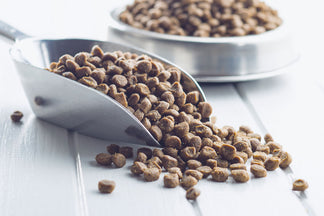Both dogs and cats were meant to eat diets high in animal proteins (and fat). This is because they are both carnivorous and their bodies require nutrition from animal flesh. Dogs, generally classified as either omnivores (able to eat a variety of animal and plant based foods) or as scavenging carnivores, are descendants of the gray wolf, a carnivore and member of the Canidae family of the mammalian order Carnivora.
Cats are classified as obligate (or true) carnivores which means that their bodies depend on the nutrients only found in animal flesh to stay healthy. While cats can consume some amounts of plant material with no ill effect, they lack the physiology required to efficiently digest vegetable matter.
The digestive tracts of dogs and cats are much smaller than those of humans. Typical food transit time is 12-30 hours for dogs and 12-24 hours for cats, much lower than the 30 hours to 5 day transit times in humans. Shorter transit times mean that dogs and cats are not able to fully process many grains and other forms of carbohydrates. Pet foods that uses grains and vegetables as protein sources are not optimal for dogs and cats. As such, it is crucial that pet owners read their pet food labels carefully to identify foods that adequately supply the correct sources of protein.
The Building Blocks
Carnivores need to eat animal protein and fat in order to be healthy. Proteins are necessary for growth and development and are key to the development and maintenance of the muscular and skeletal structures as well as the immune system. Yet it is not protein per se that is needed but the amino acids which are contained in protein that are needed. Proteins consumed in the diet are broken down into the building block amino acids by the digestive system, so the body can then use them to build, rebuild or replace cells in the body.
Dogs and cats both require 22 amino acids for proper health, some of which are ‘essential’ (from a dietary perspective) and must come from dietary sources. For dogs there are 10 essential amino acids while for cats there are 11 essential amino acids.
Proteins can be evaluated in several ways including their biological value and their digestibility.
Biological Value
Biological value compares the nutritional worth, or completeness, of different protein ingredients. It measures a protein’s ability to supply amino acids, especially the essentials, and to supply them in the appropriate proportions. Below are the biological value ratings for some proteins. You will notice immediately that meat and fish have higher values than plant and grain proteins.
|
Food |
Biological Value |
|
Eggs (whole) |
100 |
|
Chicken / Turkey |
79 |
|
Beef |
78 |
|
Fish |
70 |
|
Brown Rice |
57 |
|
Peas |
55 |
|
Whole Wheat |
49 |
|
Soy beans |
47 |
|
Corn |
36 |
|
Dry Beans |
34 |
Digestibility
This is the measure of the body’s ability to break down and digest the protein for use in cellular functions. T.J. Dunn, Jr. DVM, has published this data on digestibility of common dog food proteins. Again, notice the difference between animal and fish protein sources compared with the others.
|
Protein |
Digestibility Value |
|
Egg whites |
100 |
|
Muscle meats (chicken, beef, lamb) |
92 |
|
Organ meats (kidney, liver, heart) |
90 |
|
Milk, cheese |
89 |
|
Fish |
75 |
|
Soy |
75 |
|
Rice |
72 |
|
Oats |
66 |
|
Yeast |
63 |
|
Wheat |
60 |
|
Corn |
54 |
In short, unless there is an underlying medical reason, dogs and cats should be fed a diet with animal or fish meat as the primary protein source.
For more information on protein, see our post “Common Sources of Protein in Pet Food“.


 Food
Food
 Food
Food
 Food
Food
